Here is the Volume 6 of Hockey from When you watch something, visit us first! Mr. Manabu YAMASHITA, former Coach of Japanese men’s national Hockey team “Samurai Japan”, told us about Penalty Corner (PC) in Hockey match this time. This is the combined version of Part 8-1 through 8-3 on our YouTube channel.
In Vol.5, we learned about the theory of the Defense in the Hockey Match.
This time, with the cooperation of Japan Hockey Association, Mr. Manabu YAMASHITA, former Coach of Japanese men’s national Hockey team “Samurai Japan”, told us about Penalty Corner (PC), which is unique to Hockey. Mr. YAMASHITA was the Captain of “Samurai Japan” at Tokyo 2020 Games, and is now back in active and now is a member of it again.
We would like to thank Japan Hockey Association, especially Head Coach of Samurai Japan, Mr. Akira TAKAHASHI, for their great help in making this video. We would like to express our sincere gratitude.
.png)
Part 8-1: What happens in Penalty Corner (PC)
From Penalty Corner (PC), many goals are quite likely to be scored, and it is not an exaggeration to say that PC is the set play that decides which team wins or loses the match.
*In FIH Hockey Men’s World Cup (2023), 10.45 Penalty Corners (PC) were awarded per match and 2.14 were scored (success rate: 20.4%), and 37.8% of the total goals scored were from PC.
The basic form of PC is to pass like this from here on the back-line and shoot from here around the top of Circle with a Drag Flick to score. Defense (DF) can only protect with 5 players including Goalkeeper (GK), but Offense (OF) can spend any number of players as they wish.

Therefore, to put it extremely simply, OF can attack with 10 players against 5 DF including GK in this Circle. It will be a Set play where DF is overwhelmingly at a disadvantage. This means that the probability of scoring a goal increases in PC. Conversely, I think it is quite important for a team to be able to score goals by high possibility from PC in order to advance to higher positions in tournaments.
Some teams may not have players who can shoot by Drag Flick, in which case players may shoot by Hit from here, but if they shoot by Hit, it is a foul to shoot the ball above the goal board, so they must always shoot below the height of the board to score.
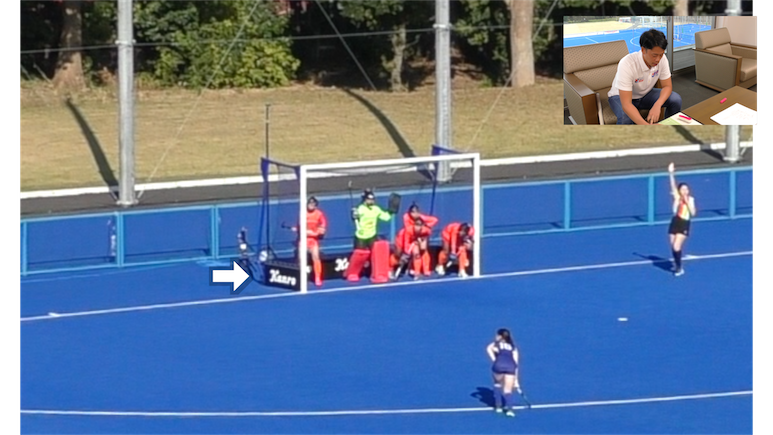
When there are players called Drag Flicker, the shot is released by Drag Flick, which is an extension of Push technique, and does not involve Hitting, so goals can be scored no matter where the shots go to anywhere of the goal.
And about the case of Touch Shooting. If another player touches a shot, goals are scored even if it is above the height of the boards, as long as another player touches and makes the ball float.
*According to FIH Rules of Hockey, “for second and subsequent hits at the goal and for flicks, deflections and scoops, it is permitted to raise the ball to any height but this must not be dangerous.” Therefore, as far as it is the second and subsequent shot, it is allowed to shoot by hit above the height of the backboard.
Completion of PC
If Drag Flicker makes a shot from here and it goes out of bounds. And, if a player makes a Pass from here but another player here misses and the ball goes outside this Hockey-specific dotted line, PC is “completed.”
*According to FIH Rules of Hockey, PC is also completed when “a goal is scored,” “a free hit is awarded to the defending team,” “the ball is played over the back-line and a penalty corner is not awarded,” “a defender commits an offence which does not result in another penalty corner” and “a penalty stroke is awarded” as well.
If the ball goes outside the dotted line here once, and then it comes back again inside the Circle and OF player makes a shoot, the situation has become Field play from PC, therefore, the goals can be scored even if the shot by Hit is above the boards.
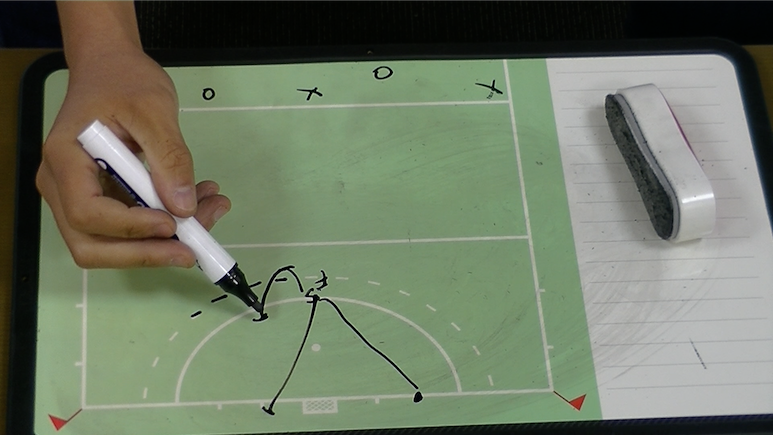
And, the horn is sounded when the time of each Quarter (Q) elapses, and if it is a PC during normal time, if the ball goes outside the dotted line, it becomes Field play, but if it is a PC when the horn sounds at the end of each Q, the match ends as soon as the ball goes outside the dotted line in that case, so OF must be very careful not to make the ball go outside the dotted line in the last-play PC.
Part 8-2: Roles of players in Penalty Corner (PC)
Roles of Offensive players in PC
There are players who are assigned special roles on Offense (OF). There is a player who serves the ball from here, and this player is called “Injector” or “Passer.” This is the first player to pass the ball.
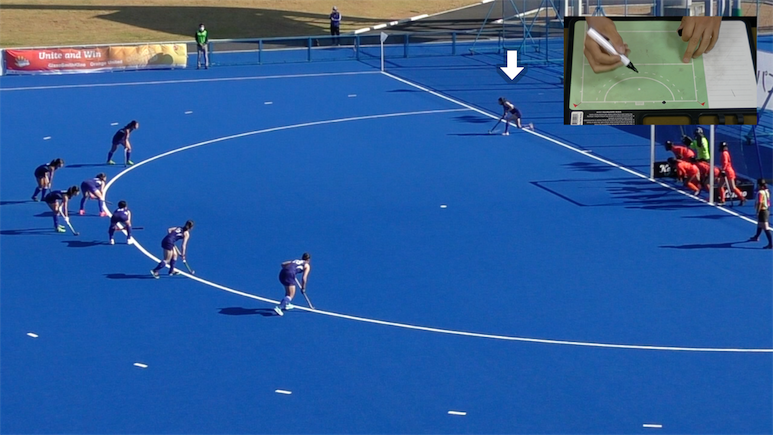
And here are “Stoppers”, the players who are to stop the ball, and there are often 2 of them set up recently, both worldwide and domestically.
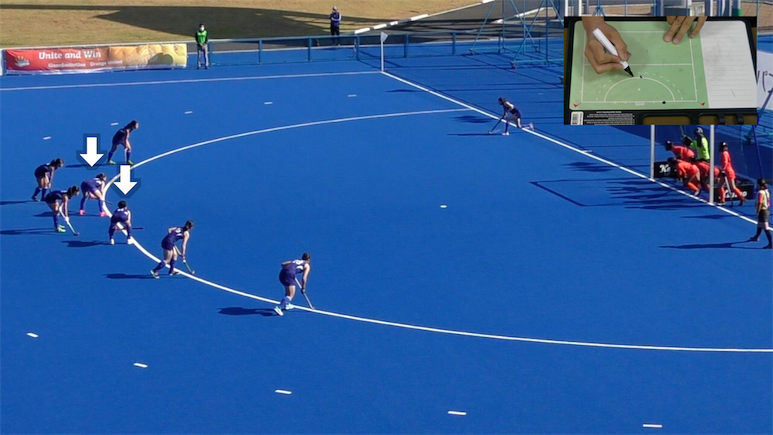
Then there are players called (Drag) Flickers, who use their Drag Flick skills to shoot and score goals, together with Stoppers around here.
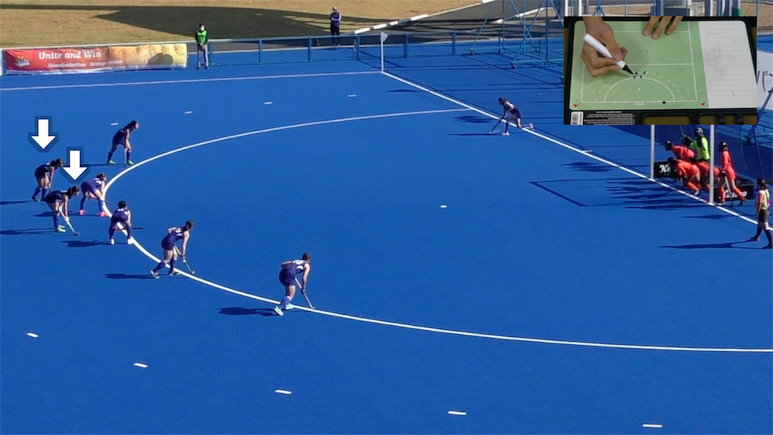
PC also allows Touch shooting, so there are usually 2 or 3 players prepared to do it.
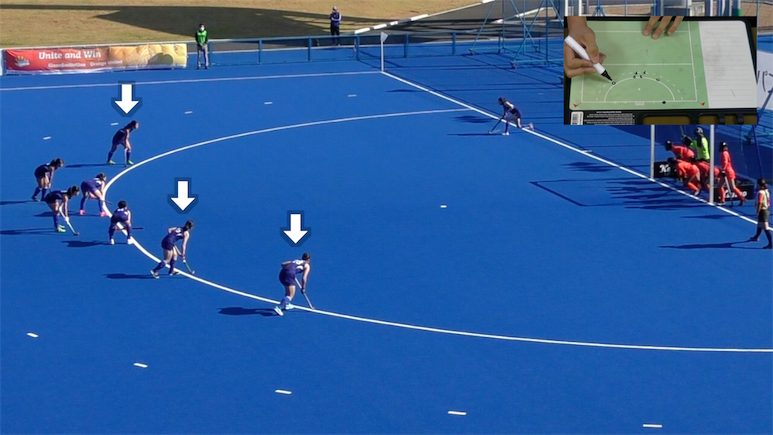
And there is a player to cover if some mistake occurs here.
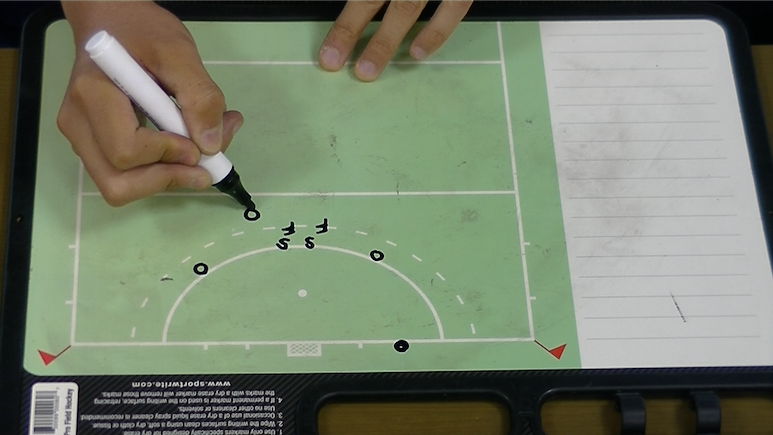
And when Defense (DF) defends PC, 4 field players must be in the goal and the rest of DF players must be on the opposite side of the goal from the half line.
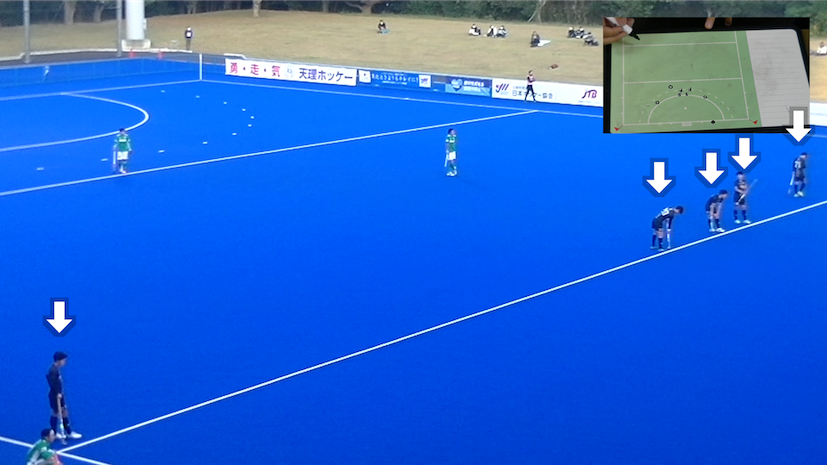
Then there may be 2 players around the half line to prevent the opponent from countering, because there are DF players near the half line who will try to counter or come back to defend.

Injector accurately passes to Stopper. Stopper then makes sure to stop the ball. Then, Flicker can make a bold move and shoot the ball which is duly stopped. This sequence of events must be perfect in order to score a goal.
The pass from Passer (=Injector) is off. Then, Flicker comes to the point of the shoot on the assumption that the ball will surely come there, therefore, if the timing is off, even a very good flicker will miss the shot, and the chance for PC may be lost, so, Injector, Stopper, and Flicker should work as one team.
I feel the difference between a team with and a team without a good Drag Flicker, who can make shots and score goals without fail.
Roles of Defensive players in PC
4 field players of Defense (DF) defending in the goal basically have roles from “1st” to “4th” against Flicker, and the player who goes first to cover the ball is “1st”. The player who moves forward after the “1st” player is “2nd.” The player in the right side of GK is “3rd.” And the player to the left side of GK is “4th.”
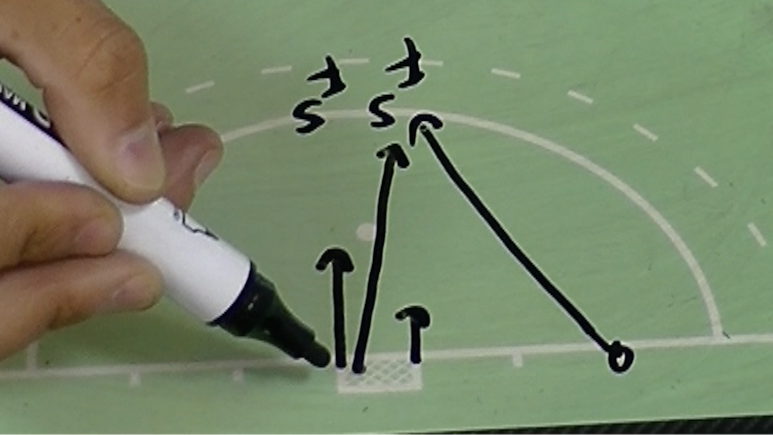
Basically, “1st” is the player who goes to put pressure on the shot of Flicker. At the same time, “1st” is also the player who has the role of physical defense to limit the course of the opponent’s shot.
As for “2nd”, this player should go next when “1st” blunders by the opponent’s feints, so 2nd needs to be careful to the situation. Or, since there is a possibility of Touch shot, 2nd also has the role of preventing that shot. So “2nd” is the player who can handle such variations.
And “3rd” is responsible for protecting the opponent’s shot from the rebound near the goal. Or, “3rd” also needs to cover Touch shot that may come from somewhere. And as for “4th”, this player protects the area of the goal that GK cannot protect.
In addition, in PC, field players of DF can use the protective gears that are not used in field play, such as gloves for both hands, knee protectors, and face masks to prevent the ball from hitting them in the face so that they will play safely.
They defend the inside of the goal. It is quite sure that the very fast ball will come through. As there are the risks of fractures and life-threatening injury, therefore, it may seem quite thrilling to the spectators but I would have to say that the actual defenders are quite danger.
Part 8-3: Penalty Corner tactics
Variations in PC
In PC, there are usually 2 Stoppers, and Stopper may stop the ball which Passer (=Injector) sends at where he/she is without moving for the flicker to shoot straight, but also Stopper may intentionally shift it to the right or left, thereby confusing the opposing defenders.
Then there is also Touch shooting. OF may choose to shoot by Touch from the right side from their point of view or from the left, depending on the opponent’s formation.
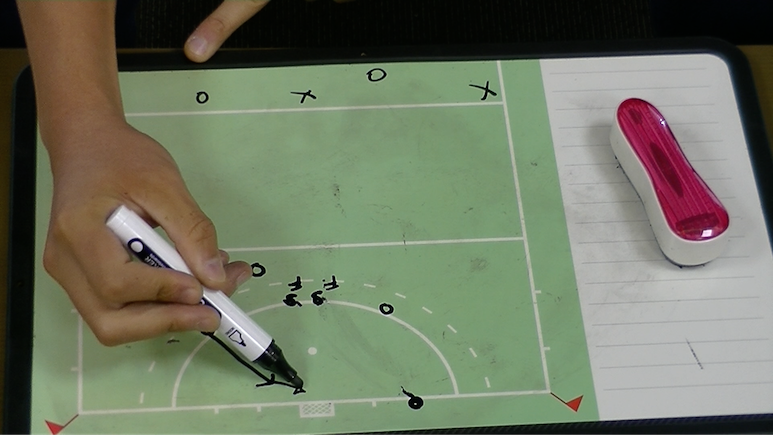
There are also variations between flickers that are quite interesting, such as this Stopper moves forward at the moment the ball is released, and this Flicker pretends to shoot, then this Stopper passes to the other Flicker and the Flicker shoots, i.e. the first Flicker pretends to shoot and send the ball to the other Flicker player, who then flicks the ball.
Strategies in PC
To increase the success rate of PC attacks, it is basically a prerequisite that the team has 1 or 2 Drag Flickers who are sure to make the shot. With 2 Flickers, DF is not able to target the ball because they doesn’t know which way the ball will come out. With only 1 Flicker, of course, DF can narrow down the target, but a team with Flicker who can still make shots is still strong.
Also, to add variations by watching how DF would defend. Even if OF has an excellent Flicker and he/she would normally shoot to score a goal, if DF responds to that shot, OF can use variations in their attack, which considerably increases their success rate. On the other hand, DF analyzes what kind of attack the opponent specializes in, for example, where the opponent tends to shoot when they move in a certain way, or the opponent’s variations, for example, the way a player moves in for Touch shot. For example, in a normal PC, a certain player may come in slowly, but such player may dash in only in a variation.
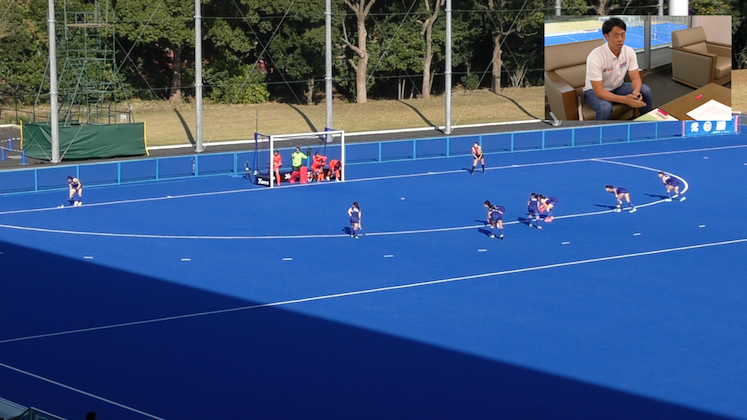
There is a tactic to be played in such predictions, and if DF wins it, I think the probability of the opponent scoring a goal will be reduced considerably.
Strategic substitutions for PC
Basically, each team makes a timetable of substitutions so that there are 2 Flickers, 2 Stoppers, and 1 Injector on the pitch, and makes the substitutions as planned.
Drag Flicker tends to be relatively DF players. DF players rather stay in the match longer than other positions, so it is not often that Drag Flickers are not on the pitch. On the other hand, since Stoppers and Injectors are rather often FW players, they are often substituted frequently, and it can happen that they are not on the pitch.
Many DF players are sturdy, and they have strong legs and back. Therefore, players who can drag the ball with Drag Flick and shoot a strong ball have a strong lower body, which is the reason why many Drag Flickers are DF players. It is often the case that a relatively sturdy player plays DF and is Drag Flicker.
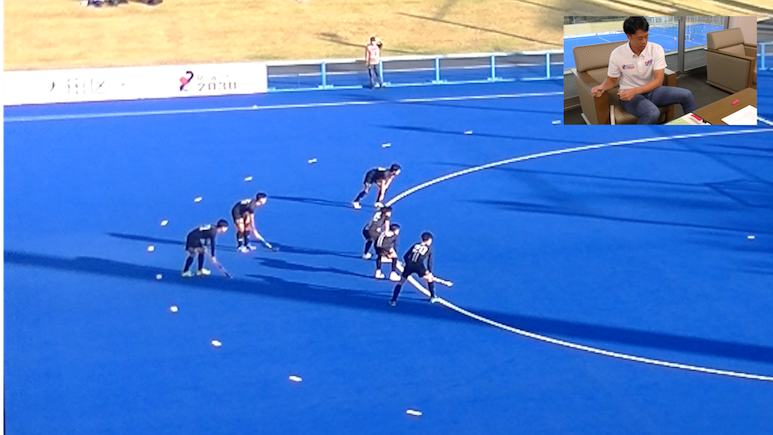
It is also quite common for a team to be short of a Stopper on the pitch due to a substitution error, and to have a dummy Stopper, but actually have another main Stopper, and on the other hand, with such a team, it may be meaningless in taking PC when they has no Flicker, so in a sense, it is a game of tactics.
Share this content:
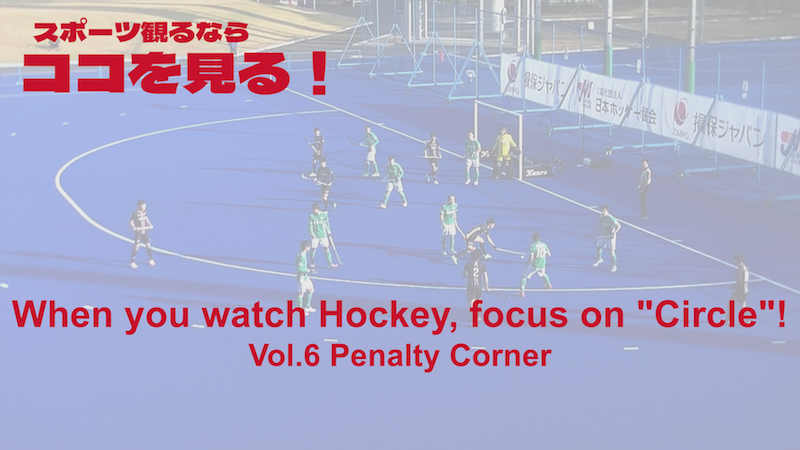
コメントを残す